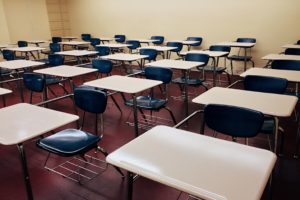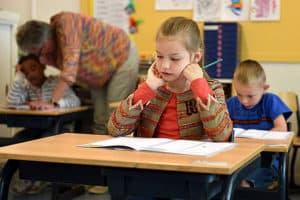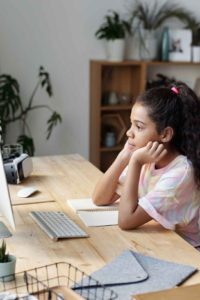[dropcap]S[/dropcap]chools throughout New York state will be able to reopen classrooms come September if certain virus-control metrics are met, but whether it’s enough to quell concerns of parents remains a variable.
On July 13, Gov. Andrew Cuomo, a Democrat, announced that any school in a region in Phase Four of the state’s economic reopening plan would be allowed to resume in-person instruction if daily COVID-19 infection rates remain under 5% over a 14-day average.
“That means the virus is under control,” Cuomo said at a press briefing. “That means it’s safer to reopen.”

All 10 regions in the state are currently in Phase Four, the final phase of reopening; New York City entered its final phase this week.
The decision to reopen individual school districts will be made during the first week in August, according to Cuomo. Westchester County, which is part of the Mid-Hudson Region, had an infection rate of 0.9% as of Wednesday.
If a region meets the state criteria, then school districts would have to comply with reopening guidelines put in place by the state Education Department, the Reimagine Education Advisory Council and the state Department of Health.
The guidance, which was made public on July 13, consists of requiring masks for students, faculty and staff while in school except for lunch periods, classes and during short breaks when social distancing is maintained. Also, at least six-feet of distancing will be required for all students and faculty while on school grounds and in facilities. To reduce social density, the guidelines recommend school districts repurpose additional indoor space and consider the usage of outdoor space where applicable. Students should also be sectioned into cohorts, or small groups that would remain in place for the duration of the public health crisis while enacting measures to ensure cohorts are not intermingling.
Each local school district in the state is now required to develop its own reopening plan by July 31, before being reviewed and approved by the state.
But parents will ultimately have the final say whether to opt-in.
Rodric Rabbah, a parent who was also a candidate for the Somers public school board this year, said he’s not comfortable with his two kids returning to school. “My view right now, I don’t think it’s going to be safe,” he said. “I’ve made the decision, I’m not sending them back in September. It’s safer all around as a family.”
Rabbah, whose youngest child is entering the first grade, said he doesn’t see how schools can effectively maintain social distancing or use cohorts with young children. “I don’t know how you get groups of five and six year olds to do that,” he said. “How do we tell young kids that they can only play with certain friends?”
Safety is also a concern for Diandra D’Amico, who has two young children in the Pelham school district. “Am I comfortable with my kids being exposed to hundreds of other kids and adults,” she said. “I’d prefer not to send them. I’m hopeful that there is going to be a remote learning option. I don’t know what happens if there isn’t remote learning.”

But remote or distance learning has proven its own set of challenges with younger students in particular, because of issues related to attention span and comprehension. The online component was also thrust in the laps of parents and teachers as many school districts tried to salvage the school year following Cuomo’s decision, on March 18, to close schools statewide due to spread of the coronavirus.
And many parents weren’t satisfied with the outcome.
Rabbah’s school board candidacy was catapulted by his belief that the Somers district wasn’t prepared for remote learning. “There was so little time that my son got to spend with his teachers,” he said. “It wasn’t every day…. Sending a link and saying ‘do this’ isn’t learning.”
Pascale Naber, a mother of three girls in the Edgemont school district—one of the top performing districts in the state—said her youngest daughter quickly lost interest with distance learning after her kindergarten class met for roughly 10 minutes every other day. “She’s too young to be learning on a laptop,” she said. Without in-person teaching, she just wasn’t interested.”
Even so, Naber, a stay-at-home mom, is still planning to home school her kids if the criteria Edgemont is developing doesn’t satisfy her concerns with the virus. “I think for me the biggest thing is not wearing a mask in class, I find that ridiculous,” she said in reference to the state’s guidance. “Masks have to be mandatory for teachers and students… the classroom size has to be something manageable.”
Rabbah, who founded his own tech company, is waiting to learn if his school district will accommodate families who want to keep their kids at home.
“I think there’s no question schools need to reopen at some point,” he said. “[But] given what is happening with the rest of the country I don’t see us being able to maintain the good that has been happening in New York until September.”
Schools will immediately close if, after Aug. 1, any region surpasses a 9% daily infection rate over a seven-day average, according to Cuomo.
“If the infection rate goes over 9 percent that means the virus is moving rapidly and it is not intelligent to open,” he said. “We’re not going to use our children as guinea pigs.”

D’Amico, who is asthmatic, worries about her own potential exposure to the coronavirus as a public school teacher in the Washington Heights section of New York City and the risk it poses to her family. She has applied for a medical exemption from the New York City Department of Education that would allow her to teach remotely, but has yet to receive an answer.
While many states see spikes in the number of COVID-19 cases, New York has reduced its overall infection rate statewide to 1.1%. Hospitalizations were down to 714 with 179 people in ICU on Wednesday. Those numbers reflect relative lows since mid-March when the COVID-19 outbreak was still early in its infancy. But New York has also suffered more than 25,000 fatalities, the highest death toll in the U.S.
“It’s purely on the numbers; it’s on the science,” Cuomo said. “Common sense and intelligence can still determine what we do.”
School reopenings, however, have become an increasingly polarizing topic as the nation inches closer to September.
In California, the Los Angeles, San Diego and Sacramento school districts announced last week that the school year would begin with distance learning due to a surge of coronavirus cases that has caused the state to close movie theaters, bars, wineries and indoor restaurants. North Carolina will reopen in August under a social distancing plan that limits the amount of students on campus. And in Florida, schools are planning to open in the fall with the goal of having classrooms reopened beginning in August.
With so much uncertainty and little guidance, parents, in many respects, have been left to their own devices to prepare their kids for the new school year regardless of where it may materialize.
“We’re flying solo here,” Naber said. “Because all of this happened at the tail end of the [school] year I think we were all a little more forgiving. However, in September something has to change. I don’t want my kids to be shortchanged and not get the education they deserve.”
CONTACT: chris@hometwn.com



